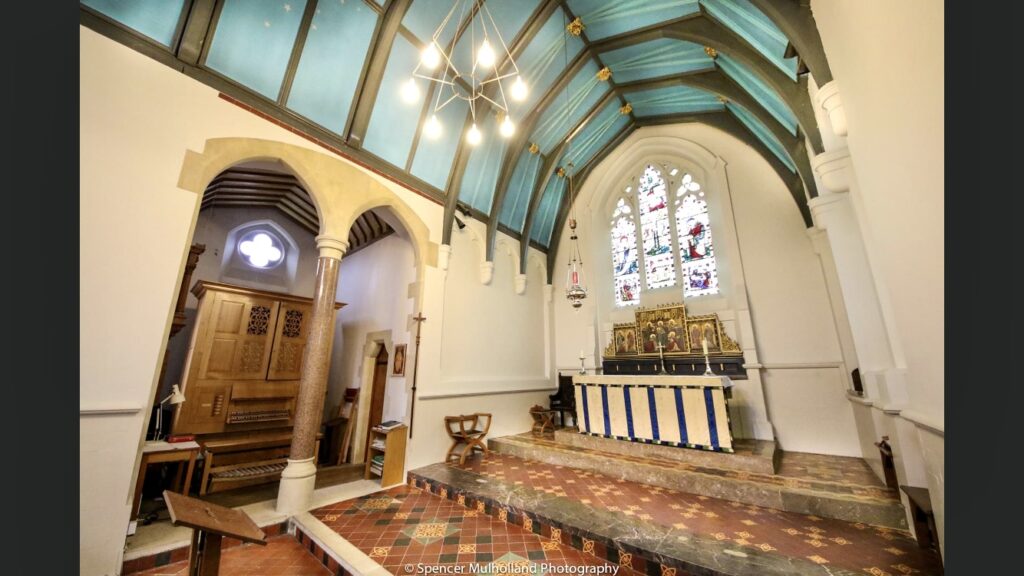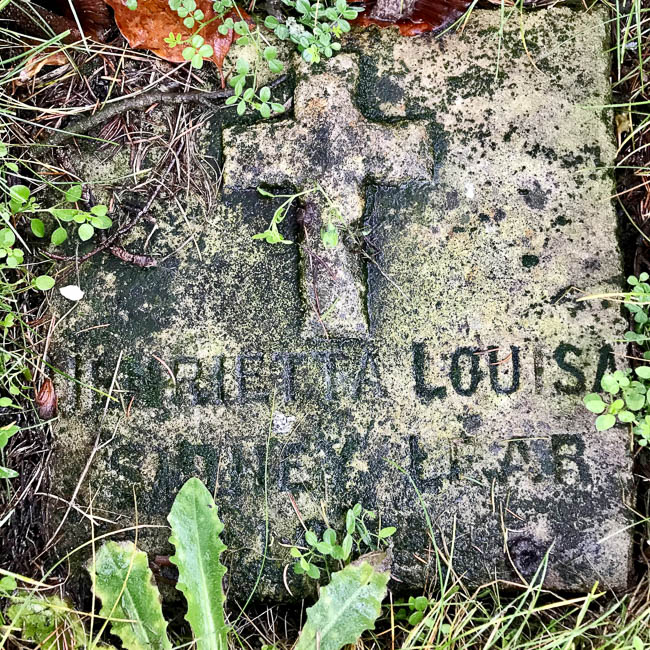A very remarkable Victorian lady, Henrietta Louisa Sidney Farrer Lear (1824-96) was a long-time resident of Salisbury’s Cathedral Close and a prolific author on religious lives. She was also a supporter of Salisbury Cathedral and the religious life of the Close.
Henrietta was born on 7 July 1824. She was the daughter of James William Farrer Esq., Barrister, and The Honourable Henrietta-Elizabeth Scott. Her grandfather was the 1st Earl of Eldon, Lord Chancellor of Great Britain. She was christened at Beckenham, Kent, and lived in London during her early life, subsequently at the family home in Devon, and then in Salisbury where she spent the later years of her life.
Henrietta Louisa Sidney Lear was an energetic English author who dedicated her talents as a writer to religious lives. She wrote (sometimes anonymously) and edited over 30 popular books on religious themes including biographies on French Catholic figures for English audiences during the mid-19th Century.1 These are still mostly in print today, and after her death they were listed under her own name. The National Trust holds many of her books including books around the religious tradition such as lenten and maigre dishes (food allowed to be eaten on fast days and in Lent).
Henrietta was also an enthusiastic supporter of her cousin Canon John Spark’s good causes, and in 1858 she used her wealthy connections to fund the House of Mercy, Horbury Institution, in Yorkshire, for “the reception and protection of women who had led unchaste lives, with a view to their reformation, either in some reputable calling by which to earn a livelihood, or otherwise”. The house provided a means for wealthy religious women to work together in sisterhoods to help those less fortunate than them. Over time it expanded to accommodate more women and took on other social causes such as education.2
In July 1859 Henrietta married Rev Sydney Henry Lear, son of the Dean of Salisbury. The marriage was widely announced in the newspapers in Salisbury, Newcastle, Cambridge, Norwich, and York.

Throughout her life Henrietta generously supported the Salisbury Theological College and contributed £4750 to the fund for the chapel and student accommodation. Other charitable causes that Henrietta supported in the city included a scheme that she had at Gigant Street close to the Anchor Inn, which provided a room equipped with games and books, which was aimed at passing labourers or those in need of shelter to have a warm and bright place to spend the evening, instead of at a public house. In 1863 Henrietta accompanied her husband at the opening of the new West Harnham School. She also supported her friend and author the highly influential Right Honourable (Elizabeth) Herbert of Lea, wife of the Lord Sidney Herbert MP (1832-1861) at various prominent local events and presentations.
When her husband died in 1867 Henrietta donated £1000 for the new choir screen at Salisbury Cathedral as a memorial to him.3 She also presented to Salisbury Cathedral various altar frontals which she had embroidered herself.
After a heart attack, the last ten years of her life were spent at home, where she continued to write and provide instruction and support to young clerics. She continued to live in the Close, with a butler, a lady’s maid, a housemaid, a cook and later a companion, until her death in 1896. Her estate was left to a relative in Dorset. The poem ‘Days and Years’4 was read at her funeral by Canon Whiteford, who remarked that “the Cathedral community had lost a true friend who had placed her trust in God and guided many in preparing for holy orders, and great men of the Church by her writings and patience in discourse on saintly lives that would not have been known to them”. A memorial stone exists in Salisbury Cathedral Cloister quarters5.
Researched and written by Heather Sheeley. Edits and notes by S. Ali.
Photo credits: photo of the memorial stone: Heather Sheeley. With thanks to Spencer Mulholland for permission to use the photograph of Sarum College.
Notes
1 From ‘The English Church Union Calendar: An Ecclesiastical Almanac for the Year of Grace 1863. The wording of this quote gives an idea of the gender roles and societal attitudes towards women at the time. Further information about this topic can be found at the following link: https://www.bl.uk/romantics-and-victorians/articles/gender-roles-in-the-19th-century.
2 The nuns remained active in the community throughout the 20th Century, and later the buildings were used for a High school and Preparatory School. The House of Mercy became part of the Silcoates Foundation. The House of Mercy, Horbury. https://www.ossett.net/beyond/HHoM.html
3 The Scott Dynasty, Salisbury Cathedral https://gilbertscott.org/salisbury-cathedral-salisbury/The Resurrection of the Salisbury Cross • V&A Blog (vam.ac.uk)
4 FOR DAYS AND YEARS A TEXT SHORT READING AND HYMN FOR EVERY DAY IN THE CHURCH S YEAR SELECTED BY H L S LEAR Poems for 23rd April
5 This may not be accessible by the general public.
Sources
Ancestry, Marriages 1859 HO 2A 29, PRO5A 136 1896 Death 8 Nov 1896
Findmypast: HO107 734/53 1841, RG12 1621/ 74 1891, RG11 2069/30 188
British Newspapers Archive, Marriage Notices 30 Jul 1859 Yorkshire Gazette, Norfolk chronicle, Newcastle Journal, Devizes and Wiltshire Gazette 30 Jul 1859 Cambridge 3498/267/56, Obituary 13 Nov 1896 Western Gazette
Sarum Theological College Account. Chapel Account book 2308/31 1915-1952 Wiltshire and Swindon Centre and Sarum College, A brief history of Sarum College, https://www.sarum.ac.uk/about/
Jane Howells, Ruth Newman. Sarum Chronicle 2014/8 Women in the Salisbury Cathedral Close, Sarum Studies 5 ISBN 978-0-9571692-4-1.
National Newspaper Archives.
Salisbury Civic Society, Magazine, December 2019. http://www.salisburycivicsociety.org.uk/wp-content/uploads/2020/09/December-2019-magazine-final.pdf
David Milborrow Salisbury Cathedral Burials 1813-1970. Wiltshire Online Parish Clerk Project/ Horbury Civic Society. House of Mercy. https://horburycivicsociety.org.uk/house-of-mercy/
National Archives Civil Registers Census, Birth, Marriage, Death.
England & Wales National Probate Calender (Index of Will and Adminstrations 1858-1995)
Publications by Henrietta Lear mostly published by Rivingtons of London and Mowbray and Co of London and Oxford:
A Christian Painter of the Nineteenth Century: Being the Life of Hippolyte Flandrin (1875)
A Dominican artist: a sketch of the life of Rev. Père Besson of the Order of St. Dominic (1870)
A Lenten Cookery Book (1876)
A Selection from Pascal’s Thoughts by Blaise Pascal, Translated by H.L.S. Lear. (1900)
Aunt Atta Aunt Atta: A Tale For Little Nephews And Nieces (1850)
Agnes Brown: Or, ‘I Will Not Offer Unto …God of That Which Doth Cost Me Nothing’ (1858).
Bossuet and his contemporaries (1874)
Christian Biographies (1888; reprint 2018)
Common-place Story (1877)
Cousin Eustace; or Conversations on the Prayer book (1869)
Fénelon, Archbishop of Cambrai; a biographical sketch (1877)
Five Minutes: Daily Readings of Poetry (1896)
For Days and Years: A Book Containing a Text, Short Reading and Hymn for Every Day in the Church’s Year (1878; reprinted 1921)
Harper’s Fine Arts Series – A History Of Architecture by Fiske Kimball, H.L. Sidney Lear (Creator) (1904)
Henri Dominique Lacordaire: a biographical sketch (1882)
Henri Perreyve by Auguste Joseph Alphonse Gratry, H.L. Sidney Lear (Creator) (1872)
Here and There: Quaint Quotations, a Book of Wit (1882)
Italian Villas and Their Gardens by Edith Wharton, Ed H.L. Sidney Lear (1904)
In Memoriam Sidney Henry Lear (1886)
Jean Baptiste Besson: A Dominican Artist: A Sketch of the Life of the Rev. Père Besson of the Order of St. Dominic (1890)
Life of Robert Gray, Bishop of Cape Town and Metropolitan of Africa (1876)
Maigre Cookery (1884)
Of the Love of God by Francis de Sales, translated by Henrietta Sidney Lear (1888)
Precious Stones. Pearls of great price. Selected passages (1881)
Readings from Holy Scripture [Old Testament] 1858
S. Francis de Sales: Bishop and Prince of Geneva by Arthur Raffalovich, H.L. Sidney Lear (1871)
S. Francis de Sales: Bishop and Prince of Geneva by H.L. Sidney Lear (1894)
Spiritual Letters Of Archbishop Fenelon: Letters To Men (1877) by François Fénelon, H.L. Sidney Lear (Translator)
Tales of Kirbeck Or, The Parish in the Fells (1850)
Tales of an English Parish (1851)
The Fathers of the Church V1 (1873)
The Hidden Life of the soul Grou, Jean Nicolas edited by H.L. Sidney Lear. (1889)
The life of Madame Louise de France, daughter of Louis XV (1869)
The light of the conscience (1876)
The Revival of Priestly Life in the Seventeenth Century in France, a Sketch by H.L. Sidney Lear (1877)
The Spirit of S. Francis de Sales, Bishop and Prince of Geneva by Jean-Pierre 1584-1652 Camus (Creator),
The Spiritual Letters Of Archbishop Fenelon: Letters To Women (1902) by François Fénelon, H.L. Sidney Lear (Editor) 1877.
Weariness (1883)
.

